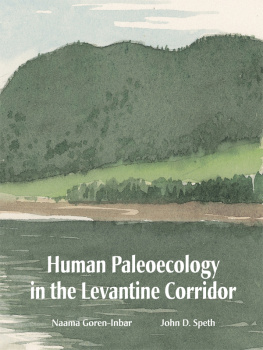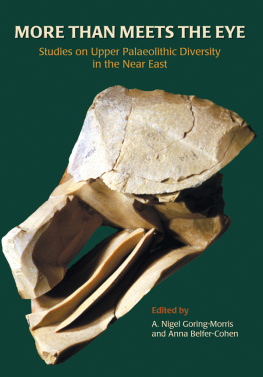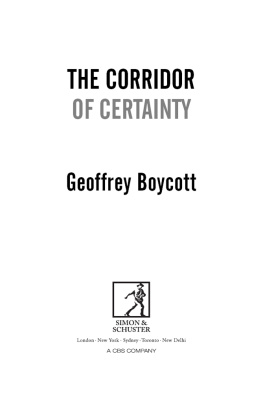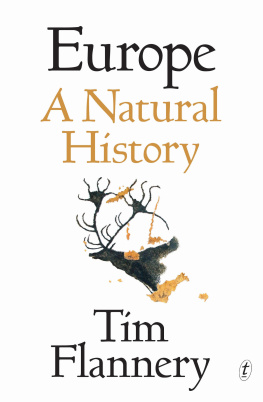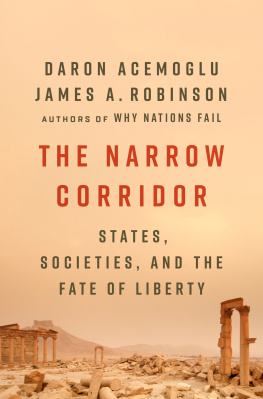
Human Paleoecology in the Levantine Corridor
Human Paleoecology in the Levantine Corridor
Naama Goren-Inbar and John D. Speth (Editors)
Oxbow Books
Human Paleoecology in the Levantine Corridor
Naama Goren-Inbar and John D. Speth (Editors)
First published in the United Kingdom in 2004. Reprinted in 2017 by
OXBOW BOOKS
The Old Music Hall, 106108 Cowley Road, Oxford OX4 1JE
and in the United States by
OXBOW BOOKS
1950 Lawrence Road, Havertown, PA 19083
Oxbow Books and the individual authors 2004
Paperback Edition: ISBN 978-1-84217-155-4
Digital Edition: ISBN 978-1-78570-963-0 (epub)
Mobi Edition: ISBN 978-1-78570-964-7 (mobi)
A CIP record for this book is available from the British Library
All rights reserved. No part of this book may be reproduced or transmitted in any form or by any means, electronic or mechanical including photocopying, recording or by any information storage and retrieval system, without permission from the publisher in writing.
For a complete list of Oxbow titles, please contact:
UNITED KINGDOM
Oxbow Books
Telephone (01865) 241249
Email:
www.oxbowbooks.com
UNITED STATES OF AMERICA
Oxbow Books
Telephone (800) 791-9354, Fax (610) 853-9146
Email:
www.casemateacademic.com/oxbow
Oxbow Books is part of the Casemate Group
Cover design and layout: Noah Lichtinger
In memory of Eitan Tchernov, a prodigious scholar who contributed enthusiastically, over many years and in many and diverse biological disciplines, to a better understanding of the Levantine Corridor
Acknowledgments
The articles in this volume are the written, and generally expanded, form of lectures given during an international conference held at the Institute for Advanced Studies of the Hebrew University of Jerusalem in July 2002. The editors would like to thank the participants for submitting newly acquired data, interesting insights, and scientifically original contributions. We thank the present Director of the Institute of Advanced Studies, B. Z. Kedar, and the previous Director, A. Levitzky, for their encouragement and support during the different stages of the program. We are very grateful to the staff of the Institute (P. Feldman, D. Aviely, O. Arbeli, S. Freiman, S. Danziger, B. Matalov, A. Orrelle, H. Kalimian, and K. Kalimian) for creating ideal conditions for scholarly work and intellectual exchange during the conference, and for making the stay at the Institute not just scientifically fruitful but also a most enjoyable experience. We thank N. Alperson (research assistant for the group) for her efficient and generous help throughout the program and in later phases as well, G. Sharon for his active involvement in and contribution to the program, and B. Sekay, Director of the Institute of Archaeology, for administrative assistance. The Institute for Advanced Studies and the Research Committee of the Faculty of Humanities at the Hebrew University of Jerusalem supported the publication of this volume. We thank Sue Gorodetsky for her continuous, meticulous and dedicated editorial help and Noah Lichtinger for her creative design and production of the book. The cover drawing is by A. Balaban. Finally, we thank D. Brown and V. Lamb of Oxbow Books for their continuous assistance in seeing this volume through to publication.
List of Tables
Chapter III
Table 1. Large mammal faunal lists of the Early Pleistocene sites of Gesher Benot Yaaqov, Israel; Ubeidiya, Israel; Dmanisi, Georgia; Venta Micena, Spain; and Ain Hanech, Algeria.
Chapter V
Table 1. Description of osseous shell anomalies and frequencies at which they appear in different populations of Trachemys scripta in North America.
Table 2. Definition and frequency of osseous shell anomalies in the present-day population of Mauremys caspica in the Jordan Valley.
Chapter VI
Table 1. Summary of analyzed faunal assemblages from sites of the Ubeidiya Formation.
Table 2. Size/weight classes for different taxa of the Ubeidiya Formation (after Bunn 1997).
Table 3. Ubeidiya layer II-24: taxa, NISP, and MNI.
Table 4. Ubeidiya layer II-24: skeletal element representation for size/weight class 2.
Table 5. Ubeidiya layer II-24: skeletal element representation for size/weight class 3.
Table 6. Ubeidiya layer II-24: skeletal element representation for size/weight class 4.
Table 7. Structural bone density of deer bones and % survivorship values for size/weight classes 24 in Ubeidiya layer II-24 by skeletal element and density scan site (after Lyman 1994: Table 7.6).
Table 8. Bone volume (cm; after Behrensmeyer 1975: Appendix 1) and size/weight classes 2 and 3 in Ubeidiya layer II- 24 by skeletal element.
Chapter XI
Table 1. Crown-height values (mm) for lower (dP) and upper (dP) deciduous fourth premolars of gazelle and fallow deer.
Chapter XII
Table 1. Stages in the draining process of the large wetlands of the Levant.
Appendix. Avian species recorded in the former wetlands of the Levant.
Chapter XIII
Table 1. Cultural periods of Jordan Valley archaeological sites.
Table 2. Jordan Valley archeological sites indicating number of identified specimens (NISP) per site and number of identified avian taxa per site (N Taxa).
Table 3. The avifauna of Amud Cave.
List of Figures
Chapter I
Figure 1. A schematic map of the hydrographic network of the Levant.
Figure 2. Superposition of the distribution of the fish genus Acanthobrama and the Levantine Corridor sensu Bar-Yosef (1998).
Chapter II
Figure 1. Location map showing the major sites discussed in the text.
Figure 2. Graphic conventions used here to indicate shifting influence of lacustrine and sub-aerial conditions in the interpretation of cyclostratigraphic patterns.
Figure 3. Sketch stratigraphic section from the elephant site in the Erq el-Ahmar Formation, based on description and sampling undertaken in August, 1999.
Figure 4. Cyclostratigraphic interpretation of the sequence at the Erq el-Ahmar elephant site.
Figure 5. Stratigraphic sections of the Ubeidiya Formation, redrawn from Picard & Baida (1966) with additional short sections described and sampled in 1999.
Figure 6. Cyclostratigraphic interpretation of the first-order variability seen in the Ubeidiya Formation.
Figure 7. Ubeidiya Fi Cycle, showing interpreted environmental fluctuations based upon the Trench II record of Picard & Baida (1966).
Figure 8. Environmental fluctuations in Ubeidiya levels II- 21 to II-26, as recorded in Profile 99-A, Trench IIb.
Figure 9. Environmental fluctuations in Ubeidiya levels III-21 to III-23, as recorded in Profile 99-B, Trench III.
Figure 10. Generalized cyclostratigraphic interpretation of environmental cycles at Ubeidiya.
Figure 11. Composite stratigraphic column from Gesher Benot Yaaqov, with sedimentary cycles and major depositional environments indicated.
Figure 12. Cyclostratigraphic interpretation of the Gesher Benot Yaaqov record.
Chapter III
Figure 1. Geographic situation of some of the most important Late Pliocene and Early Pleistocene localities of southern and western Asia, Europe and North Africa.
Figure 2. Biostratigraphic chart of selected Late Pliocene and Early Pleistocene large mammals in the Middle East and Europe.
Next page
